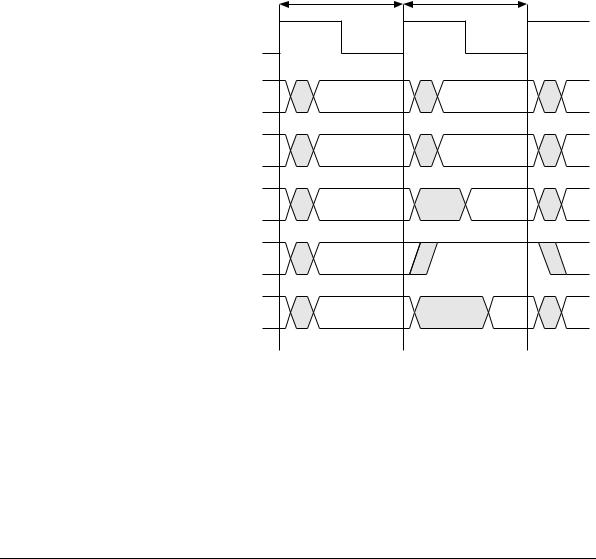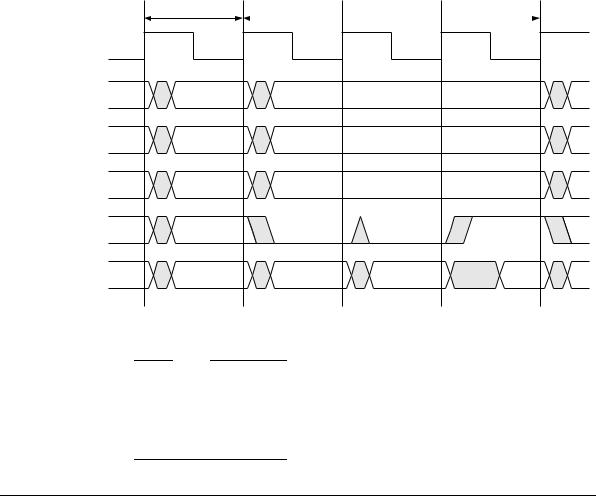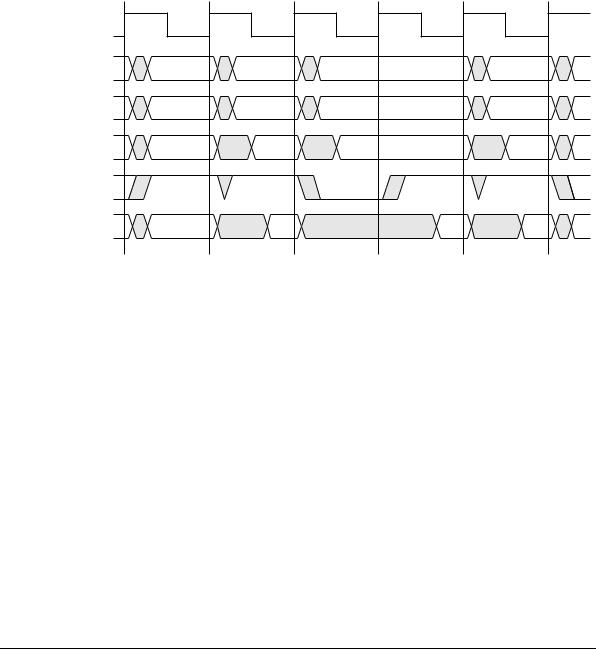
- •Preface
- •About this document
- •Feedback
- •1 Introduction to the AMBA Buses
- •1.1 Overview of the AMBA specification
- •1.1.2 Advanced System Bus (ASB)
- •1.1.3 Advanced Peripheral Bus (APB)
- •1.2 Objectives of the AMBA specification
- •1.4 Terminology
- •1.5 Introducing the AMBA AHB
- •1.6 Introducing the AMBA ASB
- •1.7 Introducing the AMBA APB
- •1.8 Choosing the right bus for your system
- •1.8.1 Choice of system bus
- •1.8.2 System bus and peripheral bus
- •1.8.3 When to use AMBA AHB/ASB or APB
- •1.9 Notes on the AMBA specification
- •1.9.1 Technology independence
- •1.9.2 Electrical characteristics
- •1.9.3 Timing specification
- •2 AMBA Signals
- •2.1 AMBA signal names
- •2.1.1 AHB signal prefixes
- •2.1.2 ASB signal prefixes
- •2.1.3 APB signal prefixes
- •2.2 AMBA AHB signal list
- •2.3 AMBA ASB signal list
- •2.4 AMBA APB signal list
- •3 AMBA AHB
- •3.1 About the AMBA AHB
- •3.2 Bus interconnection
- •3.3 Overview of AMBA AHB operation
- •3.4 Basic transfer
- •3.5 Transfer type
- •3.6 Burst operation
- •3.6.1 Early burst termination
- •3.7 Control signals
- •3.7.1 Transfer direction
- •3.7.2 Transfer size
- •3.7.3 Protection control
- •3.8 Address decoding
- •3.9 Slave transfer responses
- •3.9.1 Transfer done
- •3.9.2 Transfer response
- •3.9.4 Error response
- •3.9.5 Split and retry
- •3.10 Data buses
- •3.10.1 HWDATA[31:0]
- •3.10.2 HRDATA[31:0]
- •3.10.3 Endianness
- •3.11 Arbitration
- •3.11.1 Signal description
- •3.11.2 Requesting bus access
- •3.11.3 Granting bus access
- •3.11.4 Early burst termination
- •3.11.5 Locked transfers
- •3.11.6 Default bus master
- •3.12 Split transfers
- •3.12.1 Split transfer sequence
- •3.12.2 Multiple split transfers
- •3.12.3 Preventing deadlock
- •3.12.4 Bus handover with split transfers
- •3.13 Reset
- •3.14 About the AHB data bus width
- •3.15 Implementing a narrow slave on a wider bus
- •3.16 Implementing a wide slave on a narrow bus
- •3.16.1 Masters
- •3.17 About the AHB AMBA components
- •3.18 AHB bus slave
- •3.18.1 Interface diagram
- •3.18.2 Timing diagrams
- •3.18.3 Timing parameters
- •3.19 AHB bus master
- •3.19.1 Interface diagram
- •3.19.2 Bus master timing diagrams
- •3.19.3 Timing parameters
- •3.20 AHB arbiter
- •3.20.1 Interface diagram
- •3.20.2 Timing diagrams
- •3.20.3 Timing parameters
- •3.21 AHB decoder
- •3.21.1 Interface diagram
- •3.21.2 Timing diagram
- •3.21.3 Timing parameter
- •4 AMBA ASB
- •4.1 About the AMBA ASB
- •4.1.2 AMBA ASB and APB
- •4.2 AMBA ASB description
- •4.3 ASB transfers
- •4.3.1 Nonsequential transfer
- •4.3.2 Sequential transfer
- •4.4 Address decode
- •4.5 Transfer response
- •4.6.1 Arbiter
- •4.6.2 Bus master handover
- •4.6.3 Default bus master
- •4.6.4 Locked transfers
- •4.7 Reset operation
- •4.7.1 Exit from reset
- •4.8 Description of ASB signals
- •4.8.1 Clock
- •4.8.2 Reset
- •4.8.3 Transfer type
- •4.8.4 Address and control information
- •4.8.5 Address bus
- •4.8.6 Transfer direction
- •4.8.7 Transfer size
- •4.8.8 Protection information
- •4.8.9 Address and control signal timing
- •4.8.10 Tristate enable of address and control signals
- •4.8.11 Slave select signals
- •4.8.12 Transfer response
- •4.8.13 Data bus
- •4.8.14 Arbitration signals
- •4.9 About the ASB AMBA components
- •4.10 ASB bus slave
- •4.10.1 Interface diagram
- •4.10.2 Bus slave interface description
- •4.10.3 Timing diagrams
- •4.10.4 Timing parameters
- •4.11 ASB bus master
- •4.11.1 Interface diagram
- •4.11.2 Bus master interface description
- •4.11.3 Bus interface state machine
- •4.11.4 Bus master timing diagrams
- •4.11.5 Timing parameters
- •4.12 ASB decoder
- •4.12.1 Interface diagram
- •4.12.2 Decoder description
- •4.12.3 Timing diagrams
- •4.12.4 Timing parameters
- •4.13 ASB arbiter
- •4.13.1 Interface diagram
- •4.13.2 Arbiter description
- •4.13.3 Timing diagrams
- •4.13.4 Timing parameters
- •5 AMBA APB
- •5.1 About the AMBA APB
- •5.2 APB specification
- •5.2.1 State diagram
- •5.2.2 Write transfer
- •5.2.3 Read transfer
- •5.3 About the APB AMBA components
- •5.4 APB bridge
- •5.4.1 Interface diagram
- •5.4.2 APB bridge description
- •5.4.3 Timing diagrams
- •5.4.4 Timing parameters
- •5.5 APB slave
- •5.5.1 Interface diagram
- •5.5.2 APB slave description
- •5.5.3 Timing diagrams
- •5.5.4 Timing parameters
- •5.6 Interfacing APB to AHB
- •5.6.1 Read transfers
- •5.6.2 Write transfers
- •5.6.3 Back to back transfers
- •5.6.4 Tristate data bus implementations
- •5.7 Interfacing APB to ASB
- •5.7.1 Write transfer
- •5.7.2 Read transfer
- •5.8 Interfacing rev D APB peripherals to rev 2.0 APB
- •6 AMBA Test Methodology
- •6.1 About the AMBA test interface
- •6.2 External interface
- •6.2.1 Test bus request A
- •6.2.2 Test bus request B
- •6.2.3 Test acknowledge
- •6.2.4 Test clock
- •6.2.5 Test bus
- •6.3 Test vector types
- •6.4 Test interface controller
- •6.4.1 Test transfer parameters
- •6.4.2 Incremental addressing
- •6.4.3 Entering test mode
- •6.4.4 Address vectors
- •6.4.5 Control vector
- •6.4.6 Write test vectors
- •6.4.7 Read test vectors
- •6.4.8 Burst vectors
- •6.4.9 Changing a burst direction
- •6.4.10 Exiting test mode
- •6.5 The AHB Test Interface Controller
- •6.5.1 Control vector
- •6.6 Example AMBA AHB test sequences
- •6.6.1 Entering test mode
- •6.6.2 Write test vectors
- •6.6.3 Read transfers
- •6.6.4 Control vector
- •6.6.5 Burst vectors
- •6.6.7 Exiting test mode
- •6.7 The ASB test interface controller
- •6.7.1 Control vector bit definitions
- •6.8 Example AMBA ASB test sequences
- •6.8.1 Entering test mode
- •6.8.2 Address vectors
- •6.8.3 Control vectors
- •6.8.4 Write test vectors
- •6.8.5 Changing burst direction
- •6.8.6 Exiting test mode

AMBA AHB
3.2Bus interconnection
The AMBA AHB bus protocol is designed to be used with a central multiplexor interconnection scheme. Using this scheme all bus masters drive out the address and control signals indicating the transfer they wish to perform and the arbiter determines which master has its address and control signals routed to all of the slaves. A central decoder is also required to control the read data and response signal multiplexor, which selects the appropriate signals from the slave that is involved in the transfer.
Figure 3-2 illustrates the structure required to implement an AMBA AHB design with three masters and four slaves.
|
|
Arbiter |
|
|
|
|
|
HADDR |
|
|
HADDR |
|
HWDATA |
Slave |
Master |
HWDATA |
|
HRDATA |
# 1 |
|
|
|||
# 1 |
HRDATA |
|
|
|
|
|
|
|
|
|
|
|
HADDR |
|
|
HADDR |
|
HWDATA |
Slave |
Master |
HWDATA |
|
HRDATA |
# 2 |
Address and |
|
|||
# 2 |
HRDATA |
control mux |
|
|
|
|
|
|
|
|
|
|
HADDR |
|
|
HADDR |
|
HWDATA |
Slave |
Master |
HWDATA |
|
HRDATA |
# 3 |
Write data mux |
|
|||
# 3 |
HRDATA |
|
|
|
|
Read data mux |
|
|
|
|
|
|
|
|
|
|
|
HADDR |
|
|
|
|
HWDATA |
Slave |
|
|
|
HRDATA |
# 4 |
|
|
|
|
|
|
|
Decoder |
|
|
Figure 3-2 Multiplexor interconnection
3-4 |
© Copyright ARM Limited 1999. All rights reserved. |
ARM IHI 0011A |

AMBA AHB
3.3Overview of AMBA AHB operation
Before an AMBA AHB transfer can commence the bus master must be granted access to the bus. This process is started by the master asserting a request signal to the arbiter. Then the arbiter indicates when the master will be granted use of the bus.
A granted bus master starts an AMBA AHB transfer by driving the address and control signals. These signals provide information on the address, direction and width of the transfer, as well as an indication if the transfer forms part of a burst. Two different forms of burst transfers are allowed:
•incrementing bursts, which do not wrap at address boundaries
•wrapping bursts, which wrap at particular address boundaries.
A write data bus is used to move data from the master to a slave, while a read data bus is used to move data from a slave to the master.
Every transfer consists of:
•an address and control cycle
•one or more cycles for the data.
The address cannot be extended and therefore all slaves must sample the address during this time. The data, however, can be extended using the HREADY signal. When LOW this signal causes wait states to be inserted into the transfer and allows extra time for the slave to provide or sample data.
During a transfer the slave shows the status using the response signals, HRESP[1:0]:
OKAY |
The OKAY response is used to indicate that the transfer is |
|
progressing normally and when HREADY goes HIGH this shows |
|
the transfer has completed successfully. |
ERROR |
The ERROR response indicates that a transfer error has occurred |
|
and the transfer has been unsuccessful. |
RETRY and SPLIT |
Both the RETRY and SPLIT transfer responses indicate that the |
|
transfer cannot complete immediately, but the bus master should |
|
continue to attempt the transfer. |
In normal operation a master is allowed to complete all the transfers in a particular burst before the arbiter grants another master access to the bus. However, in order to avoid excessive arbitration latencies it is possible for the arbiter to break up a burst and in such cases the master must re-arbitrate for the bus in order to complete the remaining transfers in the burst.
ARM IHI 0011A |
© Copyright ARM Limited 1999. All rights reserved. |
3-5 |

AMBA AHB
3.4Basic transfer
An AHB transfer consists of two distinct sections:
•The address phase, which lasts only a single cycle.
•The data phase, which may require several cycles. This is achieved using the HREADY signal.
Figure 3-3 shows the simplest transfer, one with no wait states.
Address phase |
Data phase |
HCLK |
|
|
HADDR[31:0] |
A |
|
Control |
Control |
|
HWDATA[31:0] |
Data |
|
(A) |
||
|
||
HREADY |
|
|
HRDATA[31:0] |
Data |
|
(A) |
||
|
||
|
Figure 3-3 Simple transfer |
In a simple transfer with no wait states:
•The master drives the address and control signals onto the bus after the rising edge of HCLK.
•The slave then samples the address and control information on the next rising edge of the clock.
3-6 |
© Copyright ARM Limited 1999. All rights reserved. |
ARM IHI 0011A |

AMBA AHB
•After the slave has sampled the address and control it can start to drive the appropriate response and this is sampled by the bus master on the third rising edge of the clock.
This simple example demonstrates how the address and data phases of the transfer occur during different clock periods. In fact, the address phase of any transfer occurs during the data phase of the previous transfer. This overlapping of address and data is fundamental to the pipelined nature of the bus and allows for high performance operation, while still providing adequate time for a slave to provide the response to a transfer.
A slave may insert wait states into any transfer, as shown in Figure 3-4, which extends the transfer allowing additional time for completion.
Address phase |
Data phase |
HCLK
HADDR[31:0]
Control
HWDATA[31:0]
HREADY
HRDATA[31:0]
A
Control
Data
(A)
Data
(A)
Figure 3-4 Transfer with wait states
Note
For write operations the bus master will hold the data stable throughout the extended cycles.
For read transfers the slave does not have to provide valid data until the transfer is about to complete.
ARM IHI 0011A |
© Copyright ARM Limited 1999. All rights reserved. |
3-7 |

AMBA AHB
When a transfer is extended in this way it will have the side-effect of extending the address phase of the following transfer. This is illustrated in Figure 3-5 which shows three transfers to unrelated addresses, A, B & C.
HCLK
HADDR[31:0]
Control
HWDATA[31:0]
HREADY
HRDATA[31:0]
A |
B |
C |
|
Control |
Control |
Control |
|
(A) |
(B) |
(C) |
|
|
Data |
Data |
Data |
|
(A) |
(B) |
(C) |
Data |
Data |
Data |
(A) |
(B) |
(C) |
Figure 3-5 Multiple transfers
In Figure 3-5:
•the transfers to addresses A and C are both zero wait state
•the transfer to address B is one wait state
•extending the data phase of the transfer to address B has the effect of extending the address phase of the transfer to address C.
3-8 |
© Copyright ARM Limited 1999. All rights reserved. |
ARM IHI 0011A |
